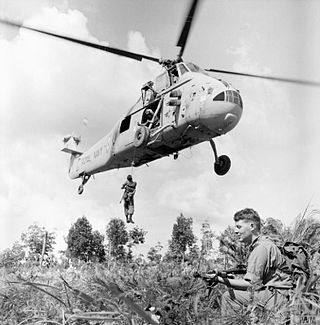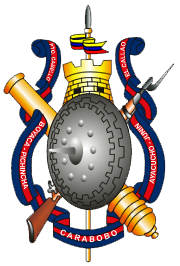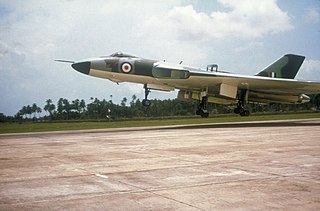
The Indonesia–Malaysia confrontation or Borneo confrontation was an armed conflict from 1963 to 1966 that stemmed from Indonesia's opposition to the creation of the state of Malaysia from the Federation of Malaya. After Indonesian president Sukarno was deposed in 1966, the dispute ended peacefully.

The Royal Malay Regiment is the premier unit of the Malaysian Army's two infantry regiments. At its largest, the Malay Regiment comprised 27 battalions. At present, three battalions are parachute trained and form part of the Malaysian Army Rapid Deployment Force. Another battalion has been converted into a mechanised infantry battalion while the remaining battalions are standard light infantry. The 1st Battalion Royal Malay Regiment acts as the ceremonial foot guards battalion for the Yang di-Pertuan Agong, and is usually accompanied by the Central Band of the Royal Malay Regiment. As its name suggests, the regiment only recruits ethnic Malays.

The Royal Ranger Regiment is an infantry regiment of the Malaysian Army. Although it is second in seniority to the Royal Malay Regiment, the RRD can trace its origins back to the mid 19th century and the establishment of The Sarawak Rangers, the peacekeeping force in the Sarawak region. This force was absorbed by the Sarawak Constabulary in 1932, but the name was revived in 1941 as a British Colonial unit; this unit commanded by British Lieutenant Colonel C.M. Lane was captured by the Japanese in 1942.

The Malaysian Army is the land component of the Malaysian Armed Forces. Steeped in British Army traditions, the Malaysian Army does not carry the title ‘royal’ as do the Royal Malaysian Navy and the Royal Malaysian Air Force. Instead, the title is bestowed on selected army corps and regiments who have been accorded the honour by the Yang di-Pertuan Agong, who is the Supreme Commander of the Malaysian Armed Forces.

Infantry is the largest formation of the Singapore Army, comprising seven active battalions—the 1st, 2nd, 3rd, 5th, 6th, 8th and 9th Battalions, Singapore Infantry Regiment (SIR)—based in Clementi Camp, Kranji Camp III, Maju Camp, Mandai Hill Camp, Selarang Camp and, an undisclosed number of reservist battalions. The Infantry formation shares the same command as that of the Singapore Army's 9th Division.

The Rejimen Askar Wataniah is the military reserve force of the Malaysian Army.

The 10th Parachute Brigade, commonly known as 10 Para, is an elite brigade-sized airborne unit within the Malaysian Army tasked with being rapidly deployed inside or outside the boundaries of Malaysia. 10 Para is the key element of the Rapid Deployment Force.

The Rejimen Artileri DiRaja is the artillery corps of the Malaysian Army. Rejimen Artileri DiRaja was formed in Kajang on 15 August 1957 when a single battery was formed, drawn from Malay personnel formerly serving with the British Army's Royal Regiment of Artillery. Today Rejimen Artileri DiRaja is a modern fighting arm providing direct fire support to Malaysian Army units using field artillery pieces and MLRS.

The Venezuelan Army, officially the Bolivarian Army of Venezuela, is the land arm of the National Bolivarian Armed Forces of Venezuela. Also known as Bolivarian Army, its role is to be responsible for land-based operations against external or internal threats that may put the sovereignty of the nation at risk. The army is the second largest military branch of Venezuela after the Bolivarian Militia.

The 5th Infantry Brigade was a regular infantry brigade of the British Army that was in existence since before the First World War, except for a short break in the late 1970s. It was an Airborne Brigade from the early 1980s until amalgamating with 24th Airmobile Brigade, in 1999, to form 16 Air Assault Brigade.

The 39th Infantry Brigade was a military formation of the British Army that was first established during the First World War and reformed in the 1950s.
The Mississippi Army National Guard is the Army National Guard component of the Mississippi National Guard. It was originally formed in 1798. It is a component of the United States Army and the United States National Guard. It is managed by the Mississippi Military Department.

The Pasukan Khas TUDM – it is better known as PASKAU – is the special operations force of the Royal Malaysian Air Force. Its main functions are to carry out high-value target protection, ground forward air controller, combat search and rescue and rescuing downed aircrew assignments. PASKAU is also tasked as the principal anti-hijack response force for military and civil aircraft in Malaysia. This task was taken over from Grup Gerak Khas. All PASKAU members are airborne and commando-trained and can be deployed behind enemy lines via air, land and sea to assist in target designation for the Malaysian Armed Forces and RMAF missions.

The General Operations Force is the light infantry arm of the Royal Malaysia Police. The General Operations Force was established in 1948 during the Malayan Emergency by the British Administration when Malaya was a colony. The police service was mobilised to the field role, primarily to engaging Communist guerrillas during the emerging Insurgency. When Malaysia was formed in 1963, this law enforcement unit was then known as the Police Field Force. The title was adopted when it dropped the previous handle widely referred to as the Jungle Squad.

The Indonesia–Malaysia confrontation began in early 1963 following Indonesia's opposition to the creation of Malaysia. Initial Indonesian attacks into East Malaysia relied heavily on local volunteers trained by the Indonesian Army. With the passage of time infiltration forces became more organised with the inclusion of a larger component of Indonesian forces. To deter and disrupt Indonesia's growing campaign of infiltrations, the British responded in 1964 by launching their own covert operations into Indonesian Kalimantan under the code name Operation Claret. Coinciding with Sukarno announcing a 'year of dangerous living' and the 1964 race riots in Singapore, Indonesia launched an expanded campaign of operations into West Malaysia on 17 August 1964, albeit without military success. A build-up of Indonesian forces on the Kalimantan border in December 1964 then saw the UK commit significant forces from the UK-based Army Strategic Command.

The Indonesia–Malaysia confrontation began in early 1963 following Indonesia's opposition to the creation of Malaysia. In December 1964, a build-up of Indonesian forces on the Kalimantan border saw the British government commit significant forces from the UK-based Army Strategic Command and Australia and New Zealand deployed roulement combat forces from West Malaysia to Borneo in 1965–66.

The 8th Battalion (Parachute), Royal Ranger Regiment (Malay: Batalion ke-8 Rejimen Renjer Diraja (Para)), better known as the 8 RRD or 8 RRD (Para) – abbreviation from its local name, is a battalion-sized airborne infantry from the Royal Ranger Regiment of the Malaysian Army. On 10 October 1994 the 8 RRD became part of the 10th Parachute Brigade. The 8 RRD is the first infantry unit in the Malaysian Army transformed from a conventional to an airborne unit.
The 9th Battalion (Parachute), Royal Malay Regiment (Malay: Batalion ke-9, Rejimen Askar Melayu Diraja (Payung Terjun)), abbreviated 9 RAMD (Para) from its local name, is a battalion-sized airborne infantry unit of the Malaysian Army's Royal Malay Regiment. Since 10 October 1994, 9 RAMD has been a part of the 10th Parachute Brigade.

The 11th Strategic Division, stylized XI Division, was a division-sized combat formation of the Malaysian Army.
The 18th Battalion (Parachute), Royal Malay Regiment (Malay: Batalion ke-18, Rejimen Askar Melayu Diraja (Payung Terjun)), abbreviated 18 RAMD (Para) from its local name, is a battalion-sized airborne infantry unit of the Malaysian Army's Royal Malay Regiment. The 18 RAMD is the newest conventional infantry unit to be promoted to an airborne unit, and they have now officially been part of the Malaysian Army's elite 10 Parachute Brigade since 21 February 2018.
















